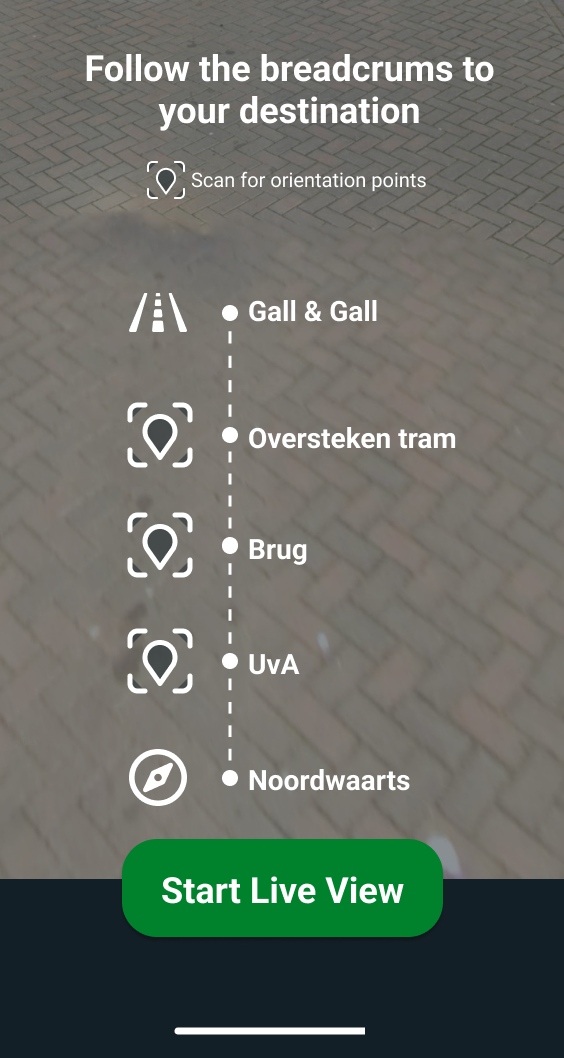Google Live Guide
Google Live Guide
As part of the Extended Reality course within the Designing for Emerging Technologies minor at the Amsterdam University of Applied Sciences, a new approach to navigation was developed. The project focused on creating an app that leverages Augmented Reality (AR) to encourage cognitive navigation, rather than reactive navigation.
Cognitive navigation emphasizes spatial awareness, memory, and orientation, while reactive navigation relies on cues prompted by an app. The developed concept is an AR app designed to encourage users to engage with their surroundings through subtle hints, fostering exploration and discovery across the city. This approach enhances the navigation experience with elements of fun and challenge, while also promoting the development of cognitive skills.
Inspiration
Inspiration for this project came from recent news stories about tourists in Amsterdam who found themselves in dangerous situations due to outdated or incorrect navigation app information. Reports of tourists riding bicycles on highways raised questions about the tendency to trust faulty information over common sense. This concern led to the development of a navigation app aimed at helping users better orient themselves in their environment.
Many individuals have become overly reliant on navigation apps that provide step-by-step directions, leading to a loss of spatial awareness and a broader understanding of their surroundings. The goal of this AR app is to encourage users to think about their routes, engage with their environment, and regain a sense of control over their navigation. By fostering this awareness, the app aims to reduce the confusion and frustration that can arise from blindly following navigation apps, ultimately improving the experience for travelers.
Problem analysis
In the initial exploration phase of the project, the objective was to understand how Augmented Reality (AR) could be leveraged to create a navigation interface that enhances users' cognitive abilities more effectively than existing digital interfaces, such as Command Line Interface (CLI), Graphical User Interface (GUI), and Natural User Interface (NUI). To delve deeper into this topic, the research was organized into several sub-questions aimed at examining the broader implications of AR navigation and its impact on cognitive navigation. This included investigating trends in AR navigation, the cognitive challenges and benefits of current navigation apps, available cognitive navigation techniques, and methods for training users to effectively utilize AR interfaces.
The research found that while current navigation apps often reduce attention and spatial awareness, they can also enhance spatial knowledge without compromising navigation performance—especially when users engage with map features for reading or surveying an area. However, media bias frequently outweighs cognitive reasoning in navigation choices. Understanding this dual effect was essential for evaluating how navigation systems influence user behavior and support the incidental acquisition of spatial knowledge.
Additionally, the more practical findings on AR trends highlighted the importance of training in the effective use of AR navigation systems. Developers must take into account both user preferences and the environmental context in which the system will be used, as these factors greatly influence usability and overall effectiveness.
Concept
The AR navigation system developed combines several concepts to create a cognitive orientation technique enhanced by Augmented Reality (AR). It provides users with step-by-step visual cues, guiding them toward their destination while promoting spatial awareness. The system begins with a general compass direction, helping users establish an overall sense of orientation. As the journey progresses, increasingly specific landmarks are presented, allowing users to refine their understanding of the environment. For the final stretch, a reimagined pathfinder is introduced, offering precise guidance for the last few meters while still encouraging the use of cognitive navigation skills.
For a successful AR experience, it is crucial to onboard the user effectively. In this system, the onboarding process explains how to use AR navigation by highlighting key landmarks, helping the user to get a clear sense of the route and task ahead. This initial guidance ensures that the user understands the app's core functionality and how to interact with the AR cues, laying the foundation for a smooth and intuitive navigation experience.
When the user needs to travel a long distance, the system displays a compass on the screen of their smartphone or AR glasses, directing them towards a waypoint—an intermediate point along their route, such as a building, intersection, roundabout, or bridge. The app provides an image of the landmark associated with the waypoint, helping the user visualize their destination. Once the user begins walking, the AR functionality is disabled, leaving only the compass for orientation. This approach ensures that the user remains cognitively engaged with their surroundings and attentive to traffic, fostering a safer and more interactive navigation experience.
As the user approaches the waypoint or an important landmark, the system provides a notification to alert them to scan for the navigational landmark. To enhance recognition, the system displays the contours of the landmark in augmented reality (AR), drawing attention to its features when the user has it in sigh with their camera. This visual emphasis helps the user easily identify the landmark and reinforces their spatial awareness, making it more memorable.
The system continuously guides the user to major landmarks and switches to a pathfinder for only the final meters of their journey once no larger landmarks remain.
This approach enables the AR navigation system to guide users intuitively and interactively, reducing the need for frequent screen-checks or verbal instructions. By leveraging the existing environment, the system enriches surroundings with relevant, highlighted information, creating a more immersive experience. This design keeps users engaged with their environment, enhancing spatial awareness and overall navigation experience.














